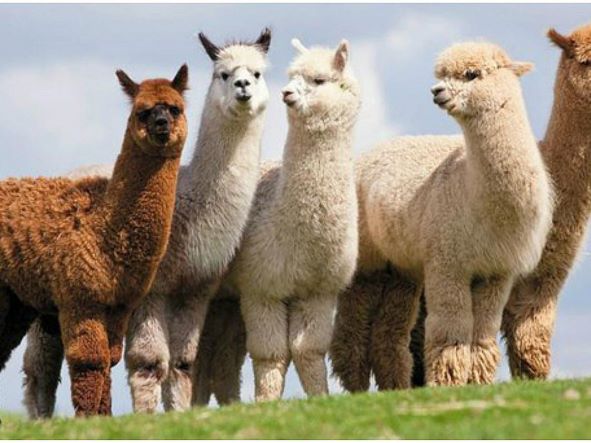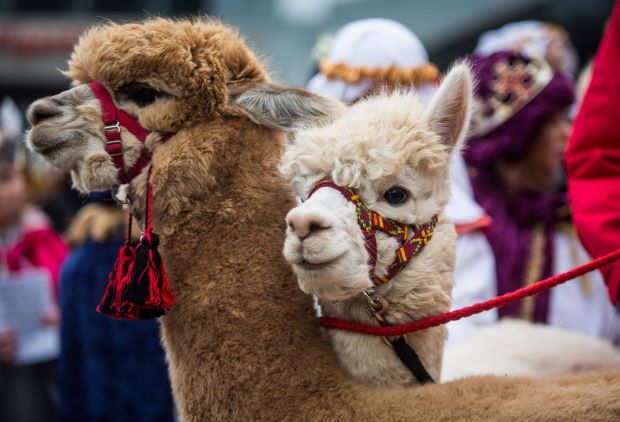Alpaca or Paco. It is one of the four South American camelids. This animal does not exist in the wild, like the Llama, it is a domestic species created by the interference of man.
What is an Alpaca?
If you are asking what is an Alpaca? Well, the alpaca, a member of the Artiodactyla order and the Camelidae family, is distinctive because it is the largest and smallest species of South American camelid. Similar to the llama and the guanaco in its external appearance, it differs in weight and size since an adult specimen measures between 81 and 99 centimeters in height and its weight ranges between 48 and 84 kilograms.
It has large, pointed ears. The body is thin and a long narrow neck protrudes; Of course, this thin neck is perceptible when it is not covered with wool, since it grows up to 50 centimeters and has a variety of white, brown and black colors. The coat can be a uniform color or multi-colored.
Its canine teeth are positioned in both jaws and are about 3 centimeters long. The female does not have as well developed canines as the male, but with the exception of this characteristic, both sexes are physically similar.
The long and soft fleece reaches in certain parts of the body, for example on the flanks, a minimum of 10 to 12 cm. The color of the animal is almost always uniform: brown, white or black, although there are also mottled individuals. Its cape is very long, almost touching the ground.
There are two breeds of alpaca: the huacaya and the suri, which are differentiated by the external characteristics of their fiber.
Like the llama and the camel, it has a habit of spitting, used to show aggressiveness or as a method of defense.
5 curiosities of the Peruvian Alpaca

alpacas peru 
- Perú is the leading producer of Alpaca fiber in the world, having 87% of the world’s population, spread over 3.6 million specimens.
- The Alpaca population in Perú represents the livelihood of 82,459 agricultural producers and is mainly concentrated in Puno (39.6%) Cusco (14.7%), Arequipa (12.7%), Huancavelica (8.3%), Apurímac (5.9%), Ayacucho (2.8 %) and Pasco (1.8%).
- Alpaca fiber is silky, elastic, soft, durable and non-flammable.
- Its fiber has unique thermal properties due to the microscopic air pockets found inside.
- This alpaca fiber appears naturally in approximately 32 shades, making it an attractive alternative to leading designers around the world.
Breeds
There are two breeds of alpaca, which are differentiated by the external characteristics of their fiber.
Huacaya
The fiber of the huacaya grows perpendicular to the body of the alpaca, it has density, softness, luster, curls (crimp) that give it a spongy appearance, the fiber wicks are shorter compared to the suri, with absence of suarda that is typical of the sheep.
Suri
The fiber of the suri grows parallel to the body of the alpaca, forming independent curlers throughout the body like the fringes of the high Andean women’s shawl, it has density, softness, and luster much more noticeable than in that of the huacaya, giving it a silky and shiny appearance.
Baby Alpaca Wool
Baby Alpaca wool is a type of Alpaca fiber. This is not the fabric of a newborn alpaca! It receives its name because it is the first shave of an alpaca, when it is less than a year old, from the lower part of the neck to the abdomen. It is at this point where the coat is at its finest, lightest and softest stage; between 21 to 23 microns in diameter (a super fine alpaca fabric is 24 to 26 microns). Since Baby Alpaca wool is so expensive, it is commonly mixed with others (such as sheep’s wool).
Royal Baby Alpaca
It is a category of baby alpaca, with fabric of less than 20 microns.
Feeding
Like the vicuña, the alpaca carries out a process of selection of plant species, as well as their most succulent parts. They have a preference for herbaceous plants and browse only in dire need. During dry periods they increase their consumption of grasses. They need to drink water every day.
Reproduction
Males reach sexual maturity between 1 and 3 years of age, while females between 1 and 2 years. After giving birth, the female is receptive again at approximately two weeks. The gestation period lasts about 345 days, after which only one baby weighing 6 or 7 kg gives birth. On very rare occasions there are cases of 2 babies. They have a longevity of approximately 20 years. Under good conditions of life and nutrition, they can live another year and in better health.
Habitat
The Alpaca has a reduced distribution; It is present in the Andean regions of South America at an altitude of 5,000 meters above sea level. It lives in Perú, Bolivia, Chile, Ecuador and Argentina but is currently also present in countries such as the United States, the Netherlands, Australia and New Zealand as a result of its introduction in the 1980s. Despite this, 99% One hundred of the alpacas live in South America.
It inhabits the mountains, savannas and grasslands of the Andean Altiplano, close to humid areas and with temperatures below 0 degrees Celsius at night.
Behavior
The alpaca no longer exists in the wild, it is grouped in herds that graze year-round in the highlands, and are only led to the barn for shearing. When an individual is separated from the rest of the herd he falls to the ground and is so stubborn that there is no way to get him up. Before bowing, he faces the worst punishments and even death. They show great affinity with water, staying for a long time in water sources and trying to step on wet places.
Threats of the Alpaca
It is known that the alpaca population is not in danger of extinction but its distribution is very limited. It is raised primarily for its fur, which is used to make fabrics used in sweaters, ponchos, coats, bedding, and much more.
It is a latent danger for the alpaca the custom of keeping it in herds together with the llama, since both species tend to mate and produce offspring with a very weak genetic constitution.
Alpaca as Pets
Due to their calm nature, is a good idea to have alpacas as pets. And they have also begun to be used in animal therapy.
Love at first sight. This is how many people describe their first encounter with an alpaca. “They have big eyes, soft fur, and you can trust them,” says Henrik Wagner, a veterinarian and owner of several alpacas himself.
Alpacas are gregarious animals and should never be alone. “Two are the minimum to have,” says Herbert Ruch, president of the International Alpacas Association. “But it is much better to have four or five,” he adds.
Whoever does not want to breed, will have to castrate the males as soon as possible, since the females are always fertile. There is no problem in having a herd of neutered males and females.
Alpacas as pets are easy to care for, but they need space. The rule is that two animals have at least a thousand square meters in a bounded meadow. For each additional animal you have to count a hundred more square meters.
Animal protection organizations also prescribe that they have a covered enclosure closed on three sides, although a stable would be better. Vaccines are also important, especially against parasites.
Once a year, before the start of summer, the alpacas must be sheared. As they cannot sweat, the heat accumulates if not under the coat of hair.
When shearing alpacas as pets, they usually remove between six and eight kilos of wool, which can be used to knit hats, scarves and sweaters, especially suitable for allergy sufferers. In fact, it is already common to see entire collections made with alpaca wool.
How much do Alpaca cost?
If you have decided to have an alapaca as pet, maybe your are asking yourself how much do Alpaca cost?
Well, be prepared to spend a lot of money. It is not usually cheap to get a good quality alpaca, although you will not need to buy a show that costs a million dollars.
So, how much do Alpaca cost? The price of each specimen is a function of the quality of its genetics, Yedra has added for whom a “genetically bad” animal produces a lower quality wool fiber that is then more difficult to place on the market and obtain performance.










